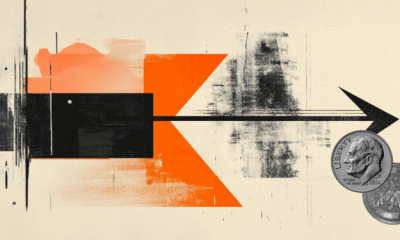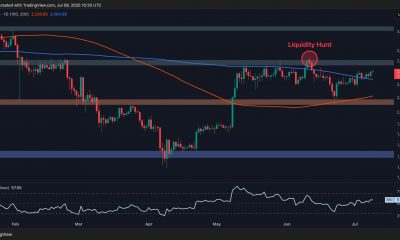

Technology
Technology is deepening civilian involvement in war – Crypto News
Small wars are fought by a country’s armed forces. Total wars are waged by entire nations. Civilians have played a huge role in the defence of Ukraine. When Ukrposhta, Ukraine’s national postal agency, held a competition to design a stamp, the winning entry depicted a tractor towing away a captured Russian tank—one of the war’s most iconic images. When Kyiv was under threat, civilians mixed Molotov cocktails to hurl at invading armoured vehicles. Volunteers have raised money for vehicles and drones. The Serhiy Prytula Foundation, a civilian charity, even bought a satellite for the army. “Kyiv has placed cross-society resistance at the heart of its national defence,” writes Hanna Shelest of Ukrainian Prism, a think-tank.
Not uncommonly for total wars, the civilian-military distinction has broken down. “A huge role was played by the local population,” says General Nikolyuk. Locals hid mobile phones from Russian troops and revealed the location of their equipment by dropping virtual pins on Google Maps (a dedicated government app, eVorog, now offers a way for civilians to pass on intelligence). Colonel Oleh Shevchuk, commander of Ukraine’s 43rd artillery brigade, and Serhiy Ogerenko, his chief of staff, speaking to Ukrainska Pravda, a newspaper, say civilians helped correct artillery fire, even using their own commercial drones.
View Full Image
Colonel Shevchuk says that, if his men knew that Russians were near a particular village but were unsure precisely where, they would open Google Maps, find a local shop and cold-call it. “Good evening, we are from Ukraine! Do you have any kaptsaps [Russians] about? Yes. Where? Where? Behind Grandma Hanna’s house. Which house is that? Well, everyone knows her! So you talk to people a little bit and work out where everything is.” On one occasion, he says, a petrol-station owner offered the password to its surveillance camera, giving the army a live view of a Chechen column heading for Kyiv.
Digitally enabled popular resistance on this scale would have been largely impossible 15 years ago. Jack McDonald of King’s College London points out that, when America invaded Afghanistan in 2001, less than 1% of the local population had access to the internet. In Syria in 2011, when a civil war was already under way and mobile-phone footage of combat became widespread, the rate was still only 22%. When Russia invaded Ukraine in 2014 it had reached 46%. When it did it again last year the figure had shot up to almost 80%. “What you’re seeing in Ukraine,” he says, “is what’s going to be standard.”
This connectivity and the proliferation of smartphones that rely on it has accelerated and transformed an older form of civilian-military collaboration, familiar from the resistance networks of occupied France in the second world war. For some time, says General Sir Jim Hockenhull, Britain’s chief of defence intelligence at the outset of the invasion, armies tried to make every soldier and platform a sensor. “What’s happened is that so many people have become sensors.” The result, he says, is a crowd-sourced “civilian sensor network” that has proved “really, really important”.
Digitally enabled popular resistance on this scale would have been impossible 15 years ago
The civilian network is not just for sensing. On February 26th, two days into the war, Mykhailo Fedorov, Ukraine’s deputy minister, publicly appealed to volunteers to conduct cyber-attacks against Russian businesses and government departments. The result was the IT Army of Ukraine, a group of nearly 200,000 volunteer hackers. Mr Fedorov asked hackers to target Russian state agencies, state-owned firms and banks.
Civilian involvement extends beyond Ukraine’s borders. By providing connectivity through its Starlink satellites, SpaceX has become an integral part of the Ukrainian army’s kill chain. Satellites operated by ICEYE, a Finnish firm, provide detailed radar images of Russian military positions. Ukraine’s Delta app, essentially a live map which fuses military intelligence from different sources, is hosted on cloud servers abroad, points out Keir Giles of Chatham House, a think-tank.
Who is fighting whom?
This growing “civilianisation of the digital battlefield”, as Kubo Macak, a legal adviser at the International Committee of the Red Cross (ICRC), calls it, has legal consequences. ICEYE satellites may be legitimate military objectives, legal experts say. Since Delta is facilitating combat operations, Russia would consider its cloud servers abroad to be “valuable targets”, suggests Mr Giles. The IT Army’s activities have prompted serious misgivings among scholars of international law and cyberspace.
A core principle of international humanitarian law is that armed forces must discriminate between combatants and non-combatants. But if civilians are building drones, hauling military gear over the border from Poland, reporting on troop movements through apps and correcting artillery fire over video chat, do they become legitimate military targets? The Geneva Conventions lay down that civilians lose protection “for such time as they take a direct part in hostilities”. But what this means is hotly disputed.
The ICRC says direct participation must involve actions that deliberately affect military operations in favour of one side. That is a high bar. Experts agree that civilians who just answer questions do not meet the threshold. Colonel Shevchuk’s phone calls would not automatically implicate those who pick up. Moreover, most intelligence passed on by apps is “too general or insignificant to meet the threshold of harm criterion,” argues Mr Macak. A civilian would have to gather and transmit information “as part of a co-ordinated operation for the purposes of a specific attack”. But flying a drone to correct shellfire would surely qualify.
One lesson is that connectivity is increasingly a vital military resource. The Taliban long ago tore down mobile-phone towers to stop Afghan villagers sending tip-offs to security forces. Mexican drug cartels now use signal-jamming equipment. General Nikolyuk says that civilian assistance was less forthcoming in Kharkiv and Donetsk in the east because Russia had disrupted mobile-phone networks in those areas.
All this presupposes that armies are making good-faith efforts to discriminate between civilians and soldiers—that they care about the laws of war. If Ukrainian civilians have so often been willing to jeopardise their status as non-combatants, it may be because Russia’s army has shown scant regard for such niceties. General Nikolyuk recalls Russian troops establishing a headquarters in a school in Yahidne, a village south of Chernihiv. Hundreds of locals were imprisoned in the basement. On another occasion in nearby Lukashivka, he says Russian soldiers, spotting a Ukrainian drone, forced women and children to walk down the street as human shields. “What do you do in such cases? You bite your fists with impotence and that’s it.”
© 2023, The Economist Newspaper Limited. All rights reserved. From The Economist, published under licence. The original content can be found on www.economist.com
-

 Blockchain1 week ago
Blockchain1 week agoBitcoin Consolidation Continues: These Are Two Key Support Levels To Watch – Crypto News
-

 Blockchain1 week ago
Blockchain1 week agoBitcoin Consolidation Continues: These Are Two Key Support Levels To Watch – Crypto News
-

 Cryptocurrency1 week ago
Cryptocurrency1 week agoTrent Share Price Crashes Over 9% After Weak Q1 Forecast, Nuvama Downgrade – Crypto News
-

 Blockchain1 week ago
Blockchain1 week agoBitcoin Consolidation Continues: These Are Two Key Support Levels To Watch – Crypto News
-

 Blockchain1 week ago
Blockchain1 week agoBitcoin Consolidation Continues: These Are Two Key Support Levels To Watch – Crypto News
-

 Blockchain1 week ago
Blockchain1 week agoBitcoin Consolidation Continues: These Are Two Key Support Levels To Watch – Crypto News
-

 Technology1 week ago
Technology1 week ago‘Notice the difference’: Elon Musk claims major upgrade to Grok chatbot’s question-answering abilities – Crypto News
-
Business1 week ago
Is Roger Ver the Satoshi Era Bitcoin Whale Behind $8 Billion BTC Transfer? – Crypto News
-
others7 days ago
Will Ethereum Price Rally to $3,200 as Wall Street Pivots from BTC to ETH – Crypto News
-
![DIS Elliott Wave technical analysis [Video]](https://dripp.zone/news/wp-content/uploads/2025/06/DIS-Elliott-Wave-technical-analysis-Video-Crypto-News-400x240.jpg)
![DIS Elliott Wave technical analysis [Video]](https://dripp.zone/news/wp-content/uploads/2025/06/DIS-Elliott-Wave-technical-analysis-Video-Crypto-News-80x80.jpg) others5 days ago
others5 days agoSkies are clearing for Delta as stock soars 13% on earnings beat – Crypto News
-
![DIS Elliott Wave technical analysis [Video]](https://dripp.zone/news/wp-content/uploads/2025/06/DIS-Elliott-Wave-technical-analysis-Video-Crypto-News-400x240.jpg)
![DIS Elliott Wave technical analysis [Video]](https://dripp.zone/news/wp-content/uploads/2025/06/DIS-Elliott-Wave-technical-analysis-Video-Crypto-News-80x80.jpg) others5 days ago
others5 days agoSkies are clearing for Delta as stock soars 13% on earnings beat – Crypto News
-
Cryptocurrency1 week ago
TON Foundation Confirms UAE Golden Visa Offer Is Not Official – Crypto News
-

 Cryptocurrency1 week ago
Cryptocurrency1 week agoBinance stacks Ethereum at yearly high, U.S. funds buy more: So why isn’t ETH moving? – Crypto News
-

 others1 week ago
others1 week agoCompany Owned by Billionaire Gold Miner May Be Seized by Russian Government for Allegedly Breaching Regulations: Report – Crypto News
-

 Blockchain6 days ago
Blockchain6 days agoInsomnia Labs Debuts Stablecoin Credit Platform for Creators – Crypto News
-

 Cryptocurrency1 week ago
Cryptocurrency1 week agoRipple CTO Reveals How Many Bitcoins He Has Mined – Crypto News
-

 De-fi1 week ago
De-fi1 week agoWorld Liberty Finance Opens Vote to List $WLFI Token – Crypto News
-

 others1 week ago
others1 week agoUS Dollar Witnesses Worst First-Half Performance in 52 Years As Money Supply Explodes To $21,942,000,000,000 – Crypto News
-

 Technology1 week ago
Technology1 week agoWe’re Losing the Plot on AI in Universities – Crypto News
-

 others1 week ago
others1 week agoAppropriate to have cautious gradual stance on easing – Crypto News
-

 others6 days ago
others6 days agoEUR/GBP posts modest gain above 0.8600 ahead of German inflation data – Crypto News
-

 Blockchain6 days ago
Blockchain6 days agoAnt Group Eyes USDC Integration Circle’s: Report – Crypto News
-

 Cryptocurrency5 days ago
Cryptocurrency5 days agoBitcoin Breaks New Record at $111K, What’s Fueling the $120K Price Target? – Crypto News
-
Technology5 days ago
XRP Eyes $3 Breakout Amid Rising BlackRock ETF Speculation – Crypto News
-

 others1 week ago
others1 week agoEyes breakout as triangle narrows, but lacks momentum – Crypto News
-
others1 week ago
Bitcoin Treasury Activity Explodes with 8,400 BTC Added in One Week – Crypto News
-

 Metaverse1 week ago
Metaverse1 week agoAre firms wasting their money on AI agents? – Crypto News
-

 Metaverse1 week ago
Metaverse1 week agoAre firms wasting their money on AI agents? – Crypto News
-

 others1 week ago
others1 week agoBank Insider Admits to Nearly Decade-Long Scheme of Falsifying Loan Applications To Steal Funds: DOJ – Crypto News
-

 Cryptocurrency1 week ago
Cryptocurrency1 week agoThis Week in Crypto Games: Planetside Dev’s ‘Reaper Actual’, What’s Next for ‘MapleStory Universe’ – Crypto News
-
Business1 week ago
Toncoin Price Drops 10% As UAE Authorities Call TON Golden Visa Offer Unofficial – Crypto News
-

 Blockchain1 week ago
Blockchain1 week agoXRP Set To Shock The Crypto Market With 30% Share: Analyst – Crypto News
-

 Cryptocurrency1 week ago
Cryptocurrency1 week agoCoinbase hacker returns with $12.5 mln ETH buy: Will security concerns affect Ethereum? – Crypto News
-
others1 week ago
Is a Pi Network Crash Ahead As 272M Coins Unlock in July – Crypto News
-
Business1 week ago
Solana ETF Launch Delayed Amid Wait for SEC’s Crypto ETF Framework – Crypto News
-

 Cryptocurrency1 week ago
Cryptocurrency1 week agoOn thinking ahead when markets get murky – Crypto News
-

 Cryptocurrency7 days ago
Cryptocurrency7 days agoIs ETH Finally Ready to Shoot For $3K? (Ethereum Price Analysis) – Crypto News
-

 Cryptocurrency6 days ago
Cryptocurrency6 days agoTornado Cash Judge Won’t Let One Case Be Mentioned in Roman Storm’s Trial: Here’s Why – Crypto News
-

 Blockchain6 days ago
Blockchain6 days agoXRP Rally Possible If Senate Web3 Crypto Summit Goes Well – Crypto News
-

 others6 days ago
others6 days agoUSD/CAD trades with positive bias below 1.3700; looks to FOMC minutes for fresh impetus – Crypto News
-

 Blockchain6 days ago
Blockchain6 days agoEthereum Bulls Roar — $3K Beckons After 5% Spike – Crypto News
-

 Blockchain6 days ago
Blockchain6 days agoKraken and Backed Expand Tokenized Equities to BNB Chain – Crypto News
-

 others6 days ago
others6 days agoNovaEx Launches with a Security-First Crypto Trading Platform Offering Deep Liquidity and Institutional-Grade Infrastructure – Crypto News
-

 Cryptocurrency6 days ago
Cryptocurrency6 days agoXRP price forecast as coins surges 2.19% to $2.33 – Crypto News
-

 Blockchain5 days ago
Blockchain5 days agoSUI Chart Pattern Confirmation Sets $3.89 Price Target – Crypto News
-
others1 week ago
Bybit Slaps 18% GST On Indian Crypto Traders Amid Stiff Tax Regime – Crypto News
-

 others1 week ago
others1 week agoScammers Drain $70,000 From Bank Accounts in Scheme Targeting JPMorgan Chase, Bank of America, Citibank and Capital One Customers: Report – Crypto News
-
Technology1 week ago
Why Are Dormant Bitcoin Whale Wallets Suddenly Waking Up? – Crypto News
-

 Blockchain1 week ago
Blockchain1 week agoBitcoin Consolidation Continues: These Are Two Key Support Levels To Watch – Crypto News
-

 others1 week ago
others1 week agoNZD/USD risks further downside as Kiwi tests critical support at 0.6050 – Crypto News








